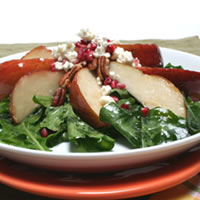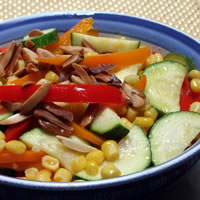Pomegranates have been part of Middle Eastern and Mediterranean cuisines for centuries, but they have only recently found a home in the American kitchen. And now they're everywhere: in juice, cocktails and chewing gum as well as in prepared dishes.
Pomegranates are being touted for their abundance of vitamin C, heart-healthy polyphenols and high levels of flavonoids, antioxidants that also seem to protect against heart disease and cancer.
According to some studies, drinking pomegranate juice can be better for you than red wine, green tea, or cranberry and orange juice. There is also a rich pomegranate concentrate that can be mixed with sparkling water or club soda. A brilliant ruby red, this drink, with a surprisingly sophisticated semi-sweet/tangy taste, is perfect for holiday entertaining of guests who want to avoid or limit alcohol intake, or trim calories.
Chefs are using fresh pomegranate seeds, pomegranate juice and even the more intensely-flavored pomegranate molasses in their cooking. Salads, entr�es and desserts all sparkle with shiny, ruby-colored seeds. Each pomegranate holds hundreds of seeds packed in compartments that are separated by bitter membranes. Each tiny seed is surrounded by a bright red pulp with a sweet-tart flavor.
It may be the difficulty of extracting the seeds that has delayed the pomegranate's popularity in America. Also, pomegranate juice can stain clothes.
To remove seeds easily, first cut the crown end off the pomegranate. Lightly slice through the skin and a little of the tissue underneath, cutting from top to bottom in four equally-spaced places, as if quartering the fruit. Immerse the pomegranate in a bowl of cool water and soak five minutes. Hold the fruit under water (which prevents juice from spattering) and pull apart the four sections. Next, separate the seeds from the rind and membrane. The seeds will sink to the bottom of the bowl, while the rind and membrane will float. Skim off and discard the rind and membrane. Drain the seeds, then pat dry.
You can also simply cut the pomegranate in half and eat the seeds with a spoon preferably while wearing a bib, apron, or stain-resistant clothes.
Pomegranates are about the size of a large orange and can vary in color from yellow to dark red. The best for eating have lots of juicy pulp.
When buying pomegranates, look for those that are heavy for their size and have a bright color and unblemished skin. Pomegranates may be refrigerated for up to two months or stored in a cool, dark place for up to a month.
A pomegranate salad would be a refreshing, pretty addition to any holiday table.
Pomegranate Salad
Makes 6 servings.
Directions
- 2 Tbsp. fresh lime juice
- 2 Tbsp. olive oil
- 1/2 tsp. Dijon mustard
- 2 medium bunches arugula, rinsed well and thick stems removed
- 2 firm but ripe pears, halved, cored and each cut into 6 wedges
- Salt and freshly ground black pepper
- 1/2 cup crumbled feta cheese (optional)
- 1/3 cup pecans, toasted and roughly chopped (optional)
- 1/2 cup pomegranate seeds (from 1 medium pomegranate)
- 18 rinsed and dried leaves of Boston, Bibb, or green-leaf lettuce (optional)
- Whisk together lime juice, oil and mustard in a small bowl.
- Place arugula and pears in a salad bowl. Toss with just enough dressing to coat. Season to taste with salt and pepper. Sprinkle with feta and pecans (if using), and pomegranate seeds, and serve. For a festive presentation, line salad plates with lettuce leaves and mound a serving of the salad in the center of each.
Nutritional Information Per Serving:
92 calories
5 g. total fat
Less than 1 g. saturated fat
14 g. carbohydrate
Less than 1 g. protein
2 g. dietary fiber
9 mg. sodium
Diabetic Exchanges: 1 Vegetable, 1/2 Low-Fat Milk, 1/2 Fruit
AICR










